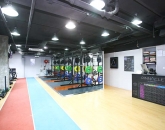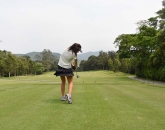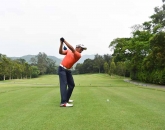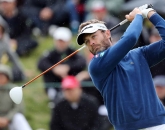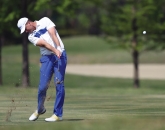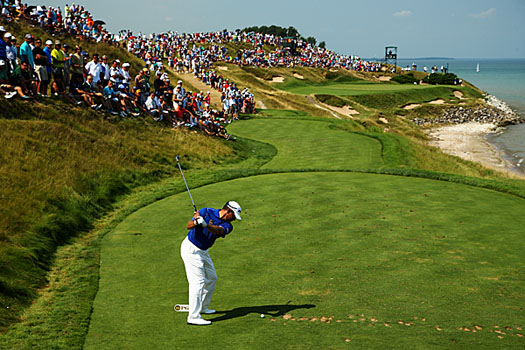
Without a doubt, the most common fault I see among amateur golfers comes at address. They don't pay enough attention to stance, posture or alignment and this has a knock-on effect on the golf swing itself. Other than that, the main fault would be not knowing how far you hit the ball. These two are actually related because it is difficult to know how far you hit each club when you have inconsistencies at set-up. I strike the ball pretty consistently every time, so I know within two or three yards how far a 7-iron is going to go, for instance. But if you're not consistent at set-up, it's going to be more difficult, so this is what you should work on in practice ...
Setting Your Stance
When I set up on the range I'm working first of all on my balance, feeling where it is in my feet at address. Most of your weight should go down through your laces as your stand over the ball. The best way to set your posture and find the right balance is to stand upright with your feet just less than shoulder width apart. Now place your shaft of your wedge across your hips. Then lean your upper body forward so your weight moves over your toes, before flexing your knees. This brings your weight back over the balls of your feet. From here, let your arms hang under your shoulders. That's the ideal set-up with good balance. You should feel like a goalkeeper ready to save a penalty. The golf swing is such a fast movement, you need to be both balanced and alive. As the clubs get longer, I tend to make my stance a bit wider, but wouldn't try to hit the ball any harder.
Checking Your Alignment
Obviously, it is important to aim in the right direction, yet strangely, most people don't! Generally I will lay a club or alignment stick on the ground. However, I don't place it on either the ball-to-target line or the line of my feet, but rather parallel to those two lines halfway between them. The alignment stick will then be beneath my shoulders and I can set my body and clubface parallel to that. Remember it is everything - feet, hips, knees, elbows - that needs to be parallel, and that's why it is so important to check. If you have any kinks in your set-up (your shoulders might be closed or your hips might be open), you'll have to make compensations in your swing to strike the ball. My hips can get slightly open every now and again, and that's why I need to check.
Pages
Click here to see the published article.



